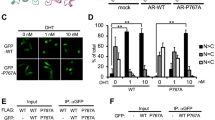Abstract
A full-length rat cDNA clone was obtained from the TR2 orphan receptor, a member of the steroid receptor superfamily, using cDNA library screening and 3′ RACE-PCR technology. Under these conditions, only the TR2-11 form of the TR2 orphan receptor, the major form found in prostate, was identified. The overall amino acid homology between human and rat TR2-11 orphan receptors was near 90% with one amino acid difference in the DNA-binding domain sequence. Northern blot analysis identified multiple forms of the TR2 orphan receptor mRNAs expressed in human and rat prostates. Androgens repressed TR2 orphan receptor mRNA levels in human prostate LNCaP cells and rat ventral prostate. Polyclonal anti-TR2 orphan receptor antibodies raised from a unique TR2 orphan receptor 20 amino acid peptide were used to localize the TR2 orphan receptor in the nuclei of prostate and epididymis epithelium cells. Together, these data demonstrate that the TR2 orphan receptor can be expressed at mRNA and protein levels in the human and rat prostrates and may have some potential function in mediating androgen action in these tissues.
Similar content being viewed by others
References
Chang, C. & Kokontis, J. (1988).Biochem. Biophys. Res. Commun.,173, 971–977.
Chang, C., Kokontis, J., Acakpo-Satchivi, L., Liao, S., Takeda H. & Chang, Y. (1989a).Biochem. Biophys. Res. Comm.,165, 735–741.
Chang, C., Kokontis, J., Liao, S.S. & Chang, Y. (1989b).J. Steroid Biochem.,34, 391–395.
Chang, C., Silva, S.L., Ideta, R., Lee, Y., Yeh, S. & Burbach, J.P.H. (1994).Proc. Natl. Acad. Sci. USA,91, 6040–6044.
Chang, C.S., Saltzman, A.G., Sorensen, N.S., Hiipakka, R.A. & Liao, S.S. (1987).J. Biol. Chem.,262, 11901–11903.
Chomczynski, P. & Sacchi, N. (1987).Nature,162, 156–159.
Fuller, P.J. (1991).FASEB J.,5, 3092–3099.
Giguere, V., Yang, N., Segui, P. & Evans, R.M. (1988).Nature,331, 91–94.
Graham, A., Hopkins, B., Powell, S.J., Danks, P. & Briggs, I. (1991).Biochem. Biophys. Res. Comm.,177, 8–16.
Horoszewicz, J.S., Leong, S.S., Kawinski, E., Karr, J.P., Rosenthal, H., Chu, T.M., Mirand, E.A. & Murphy, G.P. (1983).Cancer Res.,43, 1809–1818.
Kliewer, S.A., Umesono, K., Heyman, R.A., Mangelsdorf, D.J., Dyck, J.A. & Evans, R.M. (1992a).Proc. Natl. Acad. Sci. USA,89, 1448–1452.
Kokontis, J., Liao, S. & Chang, C. (1991).Receptor,1, 261–270.
Lazar, M.A. (1993).Endo. Rev.,14, 184–193.
Lydon, J.P., Power, R.F. & Conneely, O.M. (1992).Gene Expre.,2, 273–283.
Laudet, V., Hanni, C., Coll, J., Catzeflis, F. & Stehelin, D. (1992).EMBO J.,11, 1003–1013.
Leid, M., Kastner, P., Lyons, R., Nakshatri, H., Saunders, M., Zacharewski, T., Chen, J.Y., Staub, A., Gamier, J.M., Mader, S. & Chambon, P. (1992).Cell,68, 377–395.
Levin, A.A., Sturzenbecker, L.J., Kazmer, S., Bosakowski, T., Huselton, C., Allenby, G., Speck, J., Kratzeisen, C., Rosenberger, M. & Lovey, A. (1992).Nature,355, 359–361.
Mangelsdorf, D.J., Borgmeyer, U., Heyman, R.A., Zhou, J.Y., Ong, E.S., Oro, A.E., Kakizuka, A. & Evans, R.M. (1992).Genes & Develop.,6, 329–344.
Pearce, D. & Yamamoto, K.R. (1993).Science,259, 1161–1164.
Segraves, W.A. (1991).Cell,6, 225–228.
Takeda, H. & Chang, C. (1991).J. Endocrinol.,12, 83–89.
Author information
Authors and Affiliations
Rights and permissions
About this article
Cite this article
Ideta, R., Yeh, S., Lee, Y. et al. Gene expression of the androgen repressed rat TR2 orphan receptor: a member of steroid receptor superfamily. Endocr 3, 277–283 (1995). https://doi.org/10.1007/BF03021406
Received:
Revised:
Issue Date:
DOI: https://doi.org/10.1007/BF03021406




